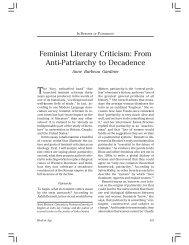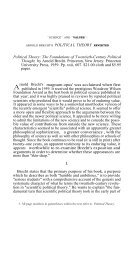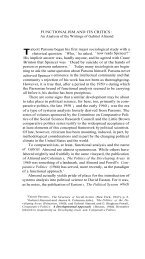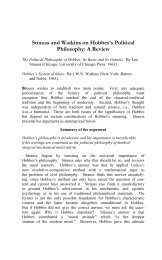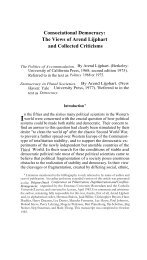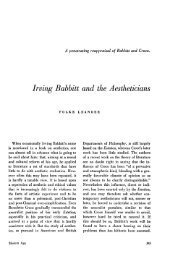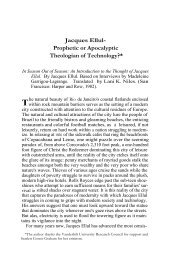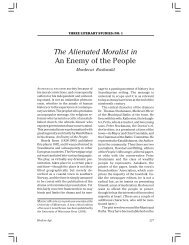Gurus and Groupies
Gurus and Groupies
Gurus and Groupies
Create successful ePaper yourself
Turn your PDF publications into a flip-book with our unique Google optimized e-Paper software.
<strong>Gurus</strong> <strong>and</strong> <strong>Groupies</strong><br />
The Golden Guru: The Strange<br />
Journey of Bhagwan Shree<br />
Rajaeesh, by James S. Gordon,<br />
Lexington, Mass: The Stephen Greene<br />
Press, 1987.<br />
Monkey on a Stick Murder, Madness,<br />
<strong>and</strong> the Hare Krishnas, by John<br />
Hubner <strong>and</strong> Lindsey Gruson, New<br />
York: Harcourt Brace Jouanouich,<br />
1988.<br />
IN A SENSE much of the major history of the<br />
twentieth century is the story of the formation,<br />
rise, <strong>and</strong> disintegration of messianic<br />
utopian cults. The Lenin cult, which<br />
began around the publication of Lenin’s<br />
newspaper Iskra in 1902, is now collapsing.<br />
The Hitler cult began in Munich in<br />
1919 <strong>and</strong> was taken apart in a horrendous<br />
goterdammerung by Allied armies<br />
in 1945 that left Germany <strong>and</strong> Europe<br />
divided by an “Iron Curtain” walling the<br />
Marxist-Leninst-Stalinists in <strong>and</strong> their<br />
hated “capitalist” enemies out.<br />
As one born into this world civil war in<br />
the 1930s, I have long been fascinated by<br />
messianic gurus like Lenin <strong>and</strong> Hitler,<br />
who promised a “Thous<strong>and</strong> Year Reich”<br />
or post-revolutionary utopia populated<br />
by “the new Soviet man,” <strong>and</strong> who recruited<br />
masses of followers <strong>and</strong> launched<br />
genocidal wars on recalcitrant,<br />
noncomforming freemen who insisted<br />
on marching to different drummers.<br />
As a young reporter I found myself<br />
reporting on such figures as George Lincoln<br />
Rockwell <strong>and</strong> his tiny American Nazi<br />
Party; <strong>and</strong> later on Tom Hayden <strong>and</strong><br />
colleagues <strong>and</strong> the Students for a Democratic<br />
Society, which gave rise to a terrorist<br />
“Weather Underground” group:<br />
then came L. Ron Hubbard <strong>and</strong> his<br />
Scientologists; Lyndon LaRouche <strong>and</strong> his<br />
Marxist-Leninist cult; <strong>and</strong> the Reverend<br />
Sun Myung Moon <strong>and</strong> his “Moonies”; the<br />
Reverend Jim Jones <strong>and</strong> his Jonestown<br />
massacre; <strong>and</strong> assorted others. It be-
came apparent that these groups follow<br />
regular patterns, a sort of “natural his-<br />
tory,” something like the patterns meteo-<br />
rologists associate with severe weather<br />
such as thunderstorms <strong>and</strong> tornadoes.<br />
To me the early phase of these social<br />
squalls is the most interesting-the emer-<br />
gence of a leader <strong>and</strong> his attraction of<br />
adherents via the magic magnetism of<br />
mass media, an essential element which<br />
we professional journalists often con-<br />
tribute unwittingly. Then comes the con-<br />
gregation of hosts of followers who be-<br />
come, in Eric Hoffer’s immortal descrip-<br />
tion, “true believers’ ready to die-<strong>and</strong><br />
often to commit mass murder-for a holy<br />
cause.<br />
In 1981 I was in Engl<strong>and</strong>, Denmark, <strong>and</strong><br />
Germany studying the Scientologists<br />
when, from European church people con-<br />
cerned about cult abuses, I began hear-<br />
ing horror stories about an Indian<br />
“ashram” or commune run by a guru<br />
called Rajneesh’, who preached a br<strong>and</strong><br />
of modern psychotherapies, Tantric<br />
yoga, <strong>and</strong> free sex. Rajneesh’s mixture of<br />
mysticism <strong>and</strong> libertinism had attracted<br />
hundreds of young Europeans <strong>and</strong> Ameri-<br />
cans, <strong>and</strong> a delegation of European<br />
church workers concerned about de-<br />
structive cults had visited the scene.<br />
A couple of years later, I read that<br />
Rajneesh had brought his commune to a<br />
farm in rural Oregon, U.S.A. Having inter-<br />
viewed some very sophisticated on-the-<br />
scene observers of Rajneesh’s ashram, I<br />
expected fireworks. I was not disap-<br />
pointed. Within three years, Rajneesh<br />
built a little empire, collected 93 Rolls<br />
Royces, plotted to take over the local<br />
government of an Oregon county, col-<br />
lected a small air force of half a dozen<br />
planes <strong>and</strong> helicopters, <strong>and</strong> began stock-<br />
piling weapons for a Hindu version of<br />
“der tag,” the old German Marxist term<br />
for preparing for the apocalyptic day of<br />
the final anticapitalist uprising.<br />
The whole story went ka-boom in late<br />
1985 when Rajneesh <strong>and</strong> his top lieuten-<br />
ant, one Ma h<strong>and</strong> Sheela, were indicted<br />
on a variety of charges. Sheela pleaded<br />
guilty <strong>and</strong> drew a twenty-year prison sen-<br />
tence. (She will serve probably only<br />
about four.) Among the crimes she ad-<br />
mitted was plotting <strong>and</strong> actually poison-<br />
ing several hundred Oregonians with<br />
salmonella, a usually non-fatal food poi-<br />
soning, so they would be too weak to go<br />
to the polls on election day, thus allow-<br />
ing the Rajneeshees to win control of the<br />
local government. She had also executed<br />
the most massive illegal wiretapping <strong>and</strong><br />
buggingscheme in U.S. history, targeting<br />
dissenters, visiting journalists, <strong>and</strong> local<br />
officials. Rajneesh was not proven to be<br />
a party to Sheela’s plots; he pleaded<br />
guilty to immigration law violations, <strong>and</strong><br />
was expelled from the United States.<br />
Now comes a former National Insti-<br />
tute of Mental Health psychiatrist, Dr.<br />
James Gordon, with a magnificent <strong>and</strong><br />
insightful insider’s view of the Rajneesh<br />
movement. Gordon went to Poona in<br />
1979 as a self-described “seeker” himself<br />
<strong>and</strong> became a friendly occasional par-<br />
ticipant observer in Rajneesh’s com-<br />
mune. But he always maintained an un-<br />
derlying scientific detachment <strong>and</strong><br />
analytical view. The result is a dramatic<br />
narrative description <strong>and</strong> analysis of the<br />
rise <strong>and</strong> fall of a messianic movement<br />
with a global reach.<br />
By coincidence another new book tells<br />
the story of another Indian Hindu monk<br />
who came to America <strong>and</strong> built a world-<br />
wide following. Swami A.C.<br />
Bhaktivendanta Prabhupada arrived in<br />
New York City in 1965 at the age of 69<br />
with seven dollars in rupees <strong>and</strong> a few<br />
battered pots <strong>and</strong> pans. In a Manhattan<br />
storefront he founded the Hare Krishna<br />
movement, based looselyon the5th cen-<br />
tury B.C. Hindu “bible,” the Bhagavad<br />
Gita. When he died in 1977 his movement<br />
had over 200 temples <strong>and</strong> farms in 60<br />
countries, tens of thous<strong>and</strong>s of follow-<br />
ers, <strong>and</strong> tens of millions of dollars. In the<br />
United States alone he had more than<br />
Modem Age 81
5000 devotees <strong>and</strong> thous<strong>and</strong>s of<br />
uninitiated believers <strong>and</strong> 57 temples <strong>and</strong><br />
farms. The Hare Krishna book, written<br />
by a pair of journalists, is excellent in its<br />
own way, <strong>and</strong> together these two books<br />
offer fascinating inquests into the collec-<br />
tive psychopathology of destructive<br />
cults.<br />
II<br />
GORDON BEGAN to investigate the cult phenomenon<br />
for NIMH in 1974. Over the next<br />
dozen years he interviewed indepthmore<br />
than 800 participants in more than forty<br />
groups, participated in their meetings<br />
<strong>and</strong> workshops, did their meditations,<br />
<strong>and</strong> lived in their communities for days<br />
or weeks. He covered Scientologists,<br />
Krishnas, Moonies, Transcendental<br />
Meditationists, Erhardists, <strong>and</strong> a host of<br />
others. But none fascinated him like<br />
Bhagwan-“the Bleeded One”-Rajneesh of<br />
Poona.<br />
When Gordon visited, some 4000 to<br />
5000 followers were in residence, many<br />
of them from Europe <strong>and</strong> America. The<br />
Poona ashram offered some sixty different<br />
therapies, with ninety psychotherapy<br />
groups functioning at once, from art<br />
therapy <strong>and</strong> encounter to primal scream<br />
<strong>and</strong> hypnosis, Gestalt, deep tissue massage,<br />
shatzu, foot reflexology, rebirthing,<br />
Rolfing, tarot, chakra balancing, a veritable<br />
gourmet supermarket of self- exploration<br />
<strong>and</strong> experimentation with forms<br />
of consciousness. In one group, the “Enlightenment<br />
Intensive,” participants sit<br />
on the floor in pairs facing one another.<br />
“Tell me who you are,” one says to the<br />
other, <strong>and</strong> after five minutes, it is the<br />
partner’s turn. They do this for four<br />
rounds, then change partners-<strong>and</strong> keep<br />
at it 14 or 16 hours a day!<br />
. Rajneesh spiced this psychic goulash<br />
with a “daily discourse,” a kind of Sermon<br />
on the Mount to his followers.<br />
Rajneesh’s commentaries on the<br />
Upanishadsaptly used Marx<strong>and</strong> Maslow,<br />
Plato <strong>and</strong> Heidegger, Freud <strong>and</strong> Beckett.<br />
A former professor of philosophy, he<br />
drew on all religions, claiming they are<br />
but one, differing only by accidents of<br />
time, place, culture-a theme unsurprising<br />
to any reader of Joseph Campbell’s<br />
four-volume work, The Masks of God.<br />
“LEAVE YOUR SHOES AND MIND OUT-<br />
SIDE,” a sign admonished. Rajneesh,<br />
wearing a white gown, arrived in a yellow<br />
Mercedes.<br />
Gordon describes his performance<br />
with great art <strong>and</strong> poetry. One wishes we<br />
had such an artist-observer to describe<br />
the early performances of Lenin <strong>and</strong><br />
Hitler. Once in a while, he drops in a sly<br />
or cynical dig that makes the reviewer<br />
think the good shrink would have made<br />
a fine journalist instead. Consider: uenlightenment<br />
is very difficult to characterize,<br />
impossible to certify, <strong>and</strong>-especially<br />
for the consumption of credulous <strong>and</strong><br />
eager seekers-easy to counterfeit.”<br />
Rajneesh drew not only on Nietzsche<br />
<strong>and</strong> Buddha, but also Barnum, <strong>and</strong> Gordon<br />
spotted it early.<br />
Rajneesh won the sobriquet of “the<br />
sex guru,” <strong>and</strong> his commune <strong>and</strong> philosophy<br />
authorized free sex, open <strong>and</strong> in any<br />
combinations the neophyte might want.<br />
Indeed, if the neophyte harbored any<br />
resistance or revulsion, the pressure was<br />
on to break it down.<br />
The term “charismatic” is often misapplied<br />
by contemporary journalists, as<br />
if it weresynonymous with “magnetic” or<br />
“persuasive,” to describe leaders. But as<br />
Ann Ruth Willner points out in her definitive<br />
study, The Spellbinders, Charismatic<br />
Political Leadership (1984), it properly<br />
describes the relationship between a<br />
leader <strong>and</strong> his followers, <strong>and</strong> thus it tells<br />
as much about the character of the followers<br />
as the leader. Gordon points to an<br />
old saying in the East: “When the disciples<br />
are ready, the guru will appear.”<br />
In 1967, America offered hordes of<br />
young adults, products of the postwar<br />
baby boom, who were questioning <strong>and</strong><br />
rejecting the Establishment <strong>and</strong> seeking<br />
Revealed Truth in radical political ide-<br />
82 Fall 1991
ologies <strong>and</strong> exotic religious systems.<br />
Indeed, the “birth dearth” of 1933-34 co-<br />
incided with the “baby boom” of 1947-63<br />
to deliver a tidal wave of young adults at<br />
exactly the time the 25-to-35-year-old co-<br />
hort bottomed out. The America of 1967<br />
had 9700 more young men in the 15-to-25<br />
age group per 100,000 mature men 25<br />
<strong>and</strong> older compared to Americaof 1955-<br />
asubstantial increasein population vola-<br />
tility. Germany had just such a maximum<br />
greening in 1928-33, when the increment<br />
of first-time new voters was 6.5 million,<br />
fully one sixth of the total. The younger<br />
voters responded heavily to the Nazi<br />
slogan, “Step down, you Old Ones!” <strong>and</strong><br />
the result was Hitler, who gained his first<br />
mass following on the college campuses.<br />
All contemporary cult leaders develop<br />
similar methods for transforming follow-<br />
ers into “true believers,” Eric Hoffer’s<br />
classic term. And they develop a com-<br />
mon apocalyptic psychology: Mankind<br />
is,at the crossroads, the elect are the<br />
vanguard, we must create a “new man”<br />
<strong>and</strong> save the world from damnation.<br />
We’ve heard that line before, too,<br />
throughout the twentieth century.<br />
Gordon vividlydescribes the recruits,<br />
the process, <strong>and</strong> the transformation of<br />
“seekers” into true believers filled with<br />
ideology, roaring with conviction, poi-<br />
soned with contempt for unbelievers,<br />
<strong>and</strong> ready to die for the leader. He took<br />
careful histories, <strong>and</strong> found that many of<br />
the followers had been seekers since<br />
childhood. From earliest consciousness<br />
they had carried a feeling they were dif-<br />
ferent, <strong>and</strong> were now questing for some<br />
sort of destiny. Many no doubt were<br />
moved by the quest for significance<br />
Ernest Becker described in his classic<br />
work, Denial ofDeath (1973). And some<br />
no doubt were schizoid personalities,<br />
neurologically fragile, fleeing a world of<br />
conflict <strong>and</strong> ambiguity in search of a<br />
perfect master to resolve all issues for<br />
them.<br />
In 1981 Rajneesh <strong>and</strong> Sheela moved<br />
their commune to a 61,000-acre ranch in<br />
central Oregon. Two years later a Uni-<br />
versity of Oregon professor found that<br />
61 percent of the population had<br />
bachelor’s degrees, 36 percent had ad-<br />
vanced degrees, <strong>and</strong> 12 percent had doc-<br />
torates. Astartling22 percent had gradu-<br />
ate or undergraduate degrees in psy-<br />
chology or psychiatry. That finding con-<br />
firmed an informal observation I made<br />
long ago as a young reporter <strong>and</strong> have<br />
reconfirmed many times that many who<br />
enter those fields do so seeking solutions<br />
to their own hang-ups.<br />
By 1985 the Oregon commune had<br />
2500 residents <strong>and</strong> 2000 longterm visi-<br />
tors. Followers bad invested more than<br />
$130 million <strong>and</strong> an incredible amount of<br />
freelabor. From thestart theRajneeshees<br />
had been at war with local residents <strong>and</strong><br />
county <strong>and</strong> state authorities. Rajneesh<br />
<strong>and</strong> Sheela, his chief of staff, kept turning<br />
up the hysteriaover the threat of nuclear<br />
war <strong>and</strong> the state of Rajneesh’s health.<br />
Fear <strong>and</strong> hostility toward the outside<br />
world <strong>and</strong> infidels reached frenzied<br />
states. Rajneeshees patrolled their ranch<br />
with helicopters <strong>and</strong> assault rifles. Psy-<br />
chiatrist Gordon watched Sheela perform<br />
at one press conference like a “malign<br />
popess” <strong>and</strong> reached this diagnosis,<br />
which is not to be found in the American<br />
Psychiatric Association’s Diagnostic <strong>and</strong><br />
Statistical Manual: “My God, I think, she<br />
really is bonkers.”<br />
On September 14 <strong>and</strong> 15, Sheela <strong>and</strong><br />
19 others fled the ranch, <strong>and</strong> on Septem-<br />
ber 16, in his morningdiscourseRajneesh<br />
accused her of turning his commune “into<br />
a fascist concentration camp.” He ac-<br />
cused her of the mass poisoning of Or-<br />
egonians <strong>and</strong> bugging. He exposed a<br />
secret laboratory where experiments<br />
were run with toxic bacteria, undetect-<br />
able poisons, <strong>and</strong> the AIDS virus. A hit<br />
list of potential assassination targets,<br />
including state <strong>and</strong> federal officials <strong>and</strong> a<br />
newspaper reporter, was discovered.<br />
Gordon believes Rajneesh accused
Sheela to beat her to the punch <strong>and</strong> stay<br />
out of jail himself. If that was his motive,<br />
it worked.<br />
“Wedon’t need Masters,”Gordon con-<br />
cludes. “They will inevitably become<br />
intoxicated with their power <strong>and</strong> encour-<br />
age those whom they promised to liber-<br />
ate to become slaves.”<br />
IlI<br />
IN MONKEY ONA STmHubner <strong>and</strong> Gruson<br />
give us a straight narrative of the Hare<br />
Krishna movement’s Manhattan beginnings,<br />
its burgeoning <strong>and</strong> fragmentation<br />
into competing cults <strong>and</strong> gurus. They<br />
then focus heavily on the degeneration<br />
of one commune in the wilds of West<br />
Virginia’s panh<strong>and</strong>le near Moundsville,<br />
where thedictator-founder was one Keith<br />
Ham. The son of a Peekskill, N.Y., fundamentalist<br />
Baptist minister. Ham was<br />
working on a doctorate in American religious<br />
history at Columbia University. He<br />
had already been to India in search of<br />
“enlightenment,” only to encounter it in<br />
the person of Prabhupada in the Bowery<br />
in 1966. His commune, which at peak had<br />
around 600 devotees, became a horrorhole<br />
of sex, drug trafficking, <strong>and</strong> murder.<br />
Indeed, one of his enforcers ranged<br />
across the continent to hunt down <strong>and</strong><br />
murder a rival in California, <strong>and</strong> after the<br />
killer was imprisoned, Ham staged an<br />
elaborate prison ceremony to elevate<br />
him to swamihood.<br />
Their story runs for 370 pages, with<br />
very little analysis, while Gordon tells<br />
the Rajneesh story with penetrating<br />
analysis in 245. Hubner <strong>and</strong> Gruson fictionalize<br />
huge hunks of dialogue <strong>and</strong><br />
other parts of their story. Unlike most<br />
such journalistic fabrication, however,<br />
they supply copious notes on sources,<br />
<strong>and</strong> exercise care to tell the interested<br />
reader what sources they relied on in<br />
creating their scenes <strong>and</strong> dialoguescourt<br />
transcripts, interviews, newspaper<br />
accounts, journalistic colleagues. While<br />
I find the practice of fictionalizing for<br />
readability generally destroys reliabil-<br />
ity, their palliative effort is helpful.<br />
By one estimate the more than 4000<br />
US. devotees Prabhupada initiated into<br />
“Krishna consciousness” have dwindled<br />
to about 500. Hubner <strong>and</strong> Gruson pro-<br />
vide us with many facts <strong>and</strong> no answers.<br />
At the end Sergeant Tom Westfall of the<br />
West Virginia State Police, the cop who<br />
became the leading expert on the<br />
Moundville commune, is trying to solve<br />
the mystery of the latest murdered body<br />
discovered there <strong>and</strong> wondering “how<br />
people who had set out to make peace<br />
<strong>and</strong> love ended up molesting children,<br />
running drugs, committing murder?”<br />
That is probably still the central prob-<br />
lem of twentieth century history.<br />
-Reviewed by Eugene H. Methvin<br />
‘Rajneesh died of heart disease on January 19,<br />
1990, at his original commune in Poona, India.<br />
Follies of Development Theory<br />
The Elementary Structures of Political<br />
Life: Rural Development in Pahlavi<br />
Iran, by Grace E. Goodell, Oxford,<br />
Engl<strong>and</strong>: Oxford University Press,<br />
1986. vii + 362 pp. $45.00.<br />
IN 1972 Grace Goodell, an anthropologist<br />
who now directs the Program on Social<br />
Change <strong>and</strong> Development at The Johns<br />
Hopkins School of Advanced Interna-<br />
tional Studies, went to Iran to study eco-<br />
nomic development in the country’s “tra-<br />
ditional” <strong>and</strong> “modern” sectors. For over<br />
two years she lived in the southwestern<br />
Iranian province of Khuzestan, first in an<br />
immemorial peasant village <strong>and</strong> later in a<br />
sort of company town where the Iranian<br />
government had resettled peasants u p<br />
rooted from the countryside. In commu-<br />
nities she calls Rahmat Abad <strong>and</strong> Bizhan,<br />
Goodell saw starkly illustrated the perni-<br />
cious practical consequences of much of



